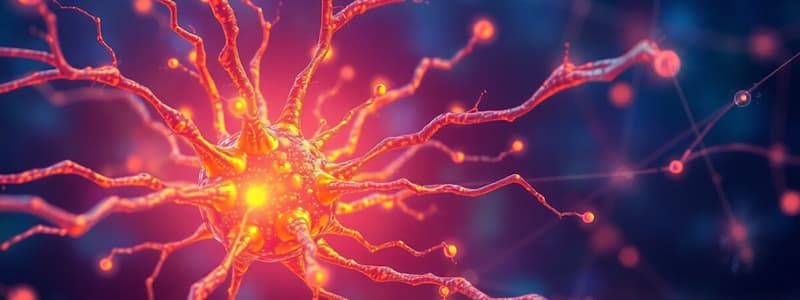Podcast
Questions and Answers
What is the primary function of a synapse?
What is the primary function of a synapse?
- To provide structural support to the brain
- To store genetic information within neurons
- To produce neurotransmitters
- To connect neurons and facilitate communication between them (correct)
Which of the following best describes the difference between chemical and electrical synapses?
Which of the following best describes the difference between chemical and electrical synapses?
- Electrical synapses are faster and more direct, while chemical synapses are slower but allow for more complex communication (correct)
- Electrical synapses use neurotransmitters while chemical synapses do not
- Chemical synapses are faster but less versatile than electrical synapses
- Chemical synapses are bidirectional while electrical synapses only send signals in one direction.
Where are neurotransmitters stored within the presynaptic neuron?
Where are neurotransmitters stored within the presynaptic neuron?
- In the postsynaptic receptors
- Within vesicles in the presynaptic terminal (correct)
- In the myelin sheath
- Inside the synaptic cleft
What is the role of ion channels in synaptic communication?
What is the role of ion channels in synaptic communication?
What is the synaptic cleft?
What is the synaptic cleft?
How do neurotransmitters influence the postsynaptic neuron?
How do neurotransmitters influence the postsynaptic neuron?
How do drugs like cocaine, amphetamines, and opioids affect brain function at the synaptic level?
How do drugs like cocaine, amphetamines, and opioids affect brain function at the synaptic level?
What does the term 'synaptic plasticity' refer to?
What does the term 'synaptic plasticity' refer to?
Flashcards
What are Synapses?
What are Synapses?
Tiny junctions between neurons, they are the 'glue' that connects neurons.
How many Synapses are there?
How many Synapses are there?
The human brain has 100 billion neurons and 100-1,000 trillion synapses. This means there are many, many more synapses than neurons.
Why are Synapses important for learning?
Why are Synapses important for learning?
Synapses are crucial for learning and memory. This means that they play a key role in how we acquire and store information.
What are the two types of Synapses?
What are the two types of Synapses?
Signup and view all the flashcards
What do Chemical Synapses use for communication?
What do Chemical Synapses use for communication?
Signup and view all the flashcards
How do Chemical Synapses work?
How do Chemical Synapses work?
Signup and view all the flashcards
What happens when neurotransmitters bind to the postsynaptic neuron?
What happens when neurotransmitters bind to the postsynaptic neuron?
Signup and view all the flashcards
How can drugs affect synapses?
How can drugs affect synapses?
Signup and view all the flashcards
Study Notes
Synapses: The Connections That Make Brains Work
- Synapses are tiny junctions linking neurons, acting as the connections between them.
- Synapses are incredibly small, 1,000 times thinner than a sheet of paper.
- Each neuron can have thousands of synapses (1,000-10,000).
- The human brain boasts 100 billion neurons and 100-1,000 trillion synapses.
- Synapses function like miniature, independent computers capable of multitasking and adjusting their strength.
- Synapses are fundamental in learning and memory processes and are linked to mental health conditions like addiction.
- Synapses are categorized as either electrical or chemical.
- Electrical synapses transmit signals rapidly and directly.
- Chemical synapses are slower but facilitate intricate communication, enabling learning and memory.
- Chemical synapses use neurotransmitters, signaling molecules released by one neuron that bind to receptors on another.
- Neurotransmitters either boost or inhibit a neuron's firing potential (excitatory or inhibitory).
- Drugs, such as cocaine, amphetamines, and opioids, can influence brain function by modifying neurotransmitter activity.
How Chemical Synapses Work
- Chemical synapses comprise two parts: the presynaptic neuron (releases neurotransmitters) and the postsynaptic neuron (receives neurotransmitters).
- The presynaptic neuron's terminal contains vesicles housing neurotransmitters.
- Postsynaptic neurons have receptors tuned to those neurotransmitters.
- The space between the two neurons is the synaptic cleft.
- Neurotransmitters are released into the cleft and bind to postsynaptic receptors.
- Receptor binding opens ion channels, permitting ion flow into the postsynaptic neuron.
- This ion flow alters the postsynaptic neuron's electrical charge, either promoting or hindering its activation.
- Neurotransmitters are essential for brain communication, influencing mood, memory, behavior, and other functions.
- Neurotransmitter activity is regulated by factors including release amounts, receptor count, and breakdown/reabsorption rates.
- Synapses possess plasticity, meaning their strength can adjust over time according to usage. This underlies learning and memory.
- Mental issues like depression, anxiety, and addiction stem from disruptions in neurotransmitter activity or synaptic plasticity.
- Drugs can modulate neurotransmitter activity by altering release, blocking reuptake, or mimicking neurotransmitters.
- Synapse research continues to advance our understanding of their operation and how they are affected by disease and drugs.
Studying That Suits You
Use AI to generate personalized quizzes and flashcards to suit your learning preferences.




